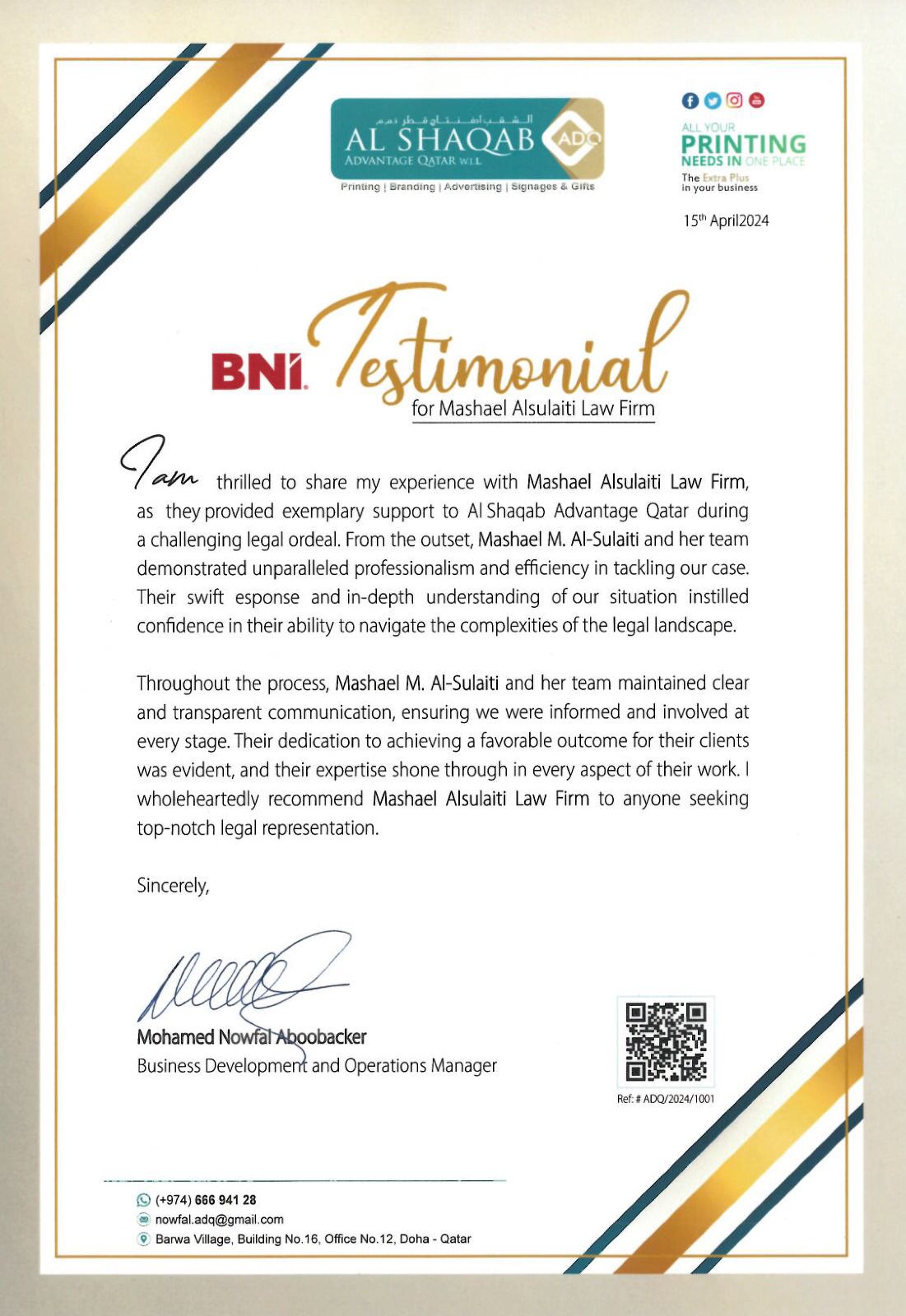Public-Private Partnerships in Qatar: Legal Insights and Strategic Opportunities under Law No. 12 of 2020

Qatar is rapidly evolving into a hub for sustainable development and international investment. A central pillar of this progress is the framework for Public-Private Partnerships (PPPs), which blend the strengths of government entities with private sector innovation and financing. The enactment of Law No. 12 of 2020 marked a turning point, offering a transparent and structured mechanism for such collaborations.
At Mashael Alsulaiti Legal Advocacy & Arbitration, we recognize that PPPs are not only development projects, they are sophisticated legal and financial undertakings. Our role is to guide clients through the complexities of contract law, regulatory compliance, and dispute resolution, ensuring their investments align with both legal requirements and strategic opportunities.
The Legal Framework: Law No. 12 of 2020
Law No. 12 of 2020 established a comprehensive foundation for PPPs in Qatar, managed by the Ministry of Commerce and Industry (MoCI) and its dedicated PPP Unit. This unit acts as the custodian of the framework, ensuring each project meets regulatory, financial, and developmental standards.
The law pursues three main objectives:
- Structuring Partnerships: It introduces clear contractual models, defining how responsibilities and risks are shared between government authorities and private companies.
- Standardizing Procedures: Through competitive tendering, bidding, and evaluation processes, it guarantees transparency and fair competition.
- Regulating Project Companies: The law governs financial guarantees, contractual obligations, and quality standards, while ensuring the eventual return of assets to the State.
For private sector participants, this framework provides legal certainty and predictability, essential for securing financing, mitigating risks, and ensuring compliance.
Application Process: How Projects Begin
The process for initiating a PPP project is clear and procedural. A concerned government entity must first submit an official initiation letter to the Business Development Department at MoCI. This letter must include a preliminary project needs assessment, outlining requirements and objectives.
The PPP Unit then studies the feasibility of implementing the project under a PPP model, ensuring it aligns with Qatar National Vision 2030 (QNV 2030) and broader national priorities. This early-stage legal and technical evaluation is critical, as it determines the project’s viability and the appropriate PPP model.
At this stage, legal counsel plays a vital role in ensuring the needs assessment, feasibility documentation, and proposed structure are robust and compliant with regulatory requirements.
Mission and Vision: PPPs and QNV 2030
Qatar’s PPP framework is designed with Qatar National Vision 2030 in mind, which seeks:
- Sustainable development.
- Economic diversification.
- Increased foreign investment.
The PPP Unit emphasizes the role of the private sector in sustaining economic growth and attracting international investment, ultimately contributing to what it calls a “free international economy without geographical restrictions.”
Its strategic objectives include:
- Building a trusted ecosystem for partnerships between public and private sectors.
- Leveraging international best practices to educate stakeholders.
- Supporting ministries and contracting authorities with legal and technical expertise.
- Ensuring fairness, transparency, and accountability in the partnership process.
- Developing a pipeline of future projects to attract private sector participation.
At Mashael Alsulaiti Legal Advocacy & Arbitration, we help clients translate these objectives into actionable strategies, ensuring they can engage effectively with the State while safeguarding their commercial interests.
Key Drivers for PPP Projects
Qatar’s government views PPPs as more than financial instruments; they are drivers of innovation, efficiency, and diversification. Law No. 12 of 2020 enables contractual partnerships between the public and private sectors to implement and finance vital assets and services.
Key drivers include:
- Expanding private sector participation in infrastructure and socially impactful projects.
- Improving efficiency of public services by leveraging private expertise.
- Encouraging technology transfer from private operators to public institutions.
- Broadening Qatar’s economic base and diversifying sources of income.
This legal framework ensures that PPPs not only fill financial gaps but also introduce global know-how and innovation into Qatar’s development process.
PPP Models: Legal Options for Structuring Partnerships
Qatar recognizes multiple models, each with distinct legal implications:
- Build-Operate-Transfer (BOT): Private entities design, finance, and operate assets before transferring them back to the State.
- Operation and Management (O&M): Private operators manage public assets under performance-linked contracts.
- Build-Own-Operate-Transfer (BOOT): Investors own and operate assets during the contract term, requiring clear clauses on ownership, liability, and eventual transfer.
- Build-Transfer-Operate (BTO): Assets are transferred upon construction, but operation rights remain with the private partner for a set period.
- Custom Models: The Council of Ministers may approve innovative structures proposed by the Minister of Commerce and Industry.
Each model demands careful contract negotiation, risk assessment, and regulatory compliance, areas where specialized legal advisory is indispensable.
Sectors and Current Projects
Qatar has already launched PPPs in education and sanitation, including school infrastructure packages and wastewater treatment facilities. Other targeted sectors include:
- Healthcare: Hospitals and specialized medical facilities.
- Infrastructure: Roads, bridges, and transport hubs.
- Renewable Energy: Clean energy and sustainability projects.
Projects are classified into three stages on the MoCI portal:
- Under Study: Initial feasibility and assessment.
- Procurement Stage: Bidding and proposal submissions.
- Implementation: Active projects with contracts awarded.
Private partners may also receive land through leases or usufruct rights, enabling development while the State retains ownership.
Governance and Oversight
To safeguard public resources and ensure project success, Qatar has adopted a multi-layered governance system:
- Prime Minister: Final approval for project concepts and preferred bidders.
- MoCI PPP Unit: Supervises implementation and ensures compliance with partnership law.
- Project Committees: Oversight bodies including MoCI, contracting authorities, and the State Audit Bureau.
- Ministry of Finance: Allocates financial resources and ensures fiscal discipline.
- Contracting Authorities: Execute contracts and monitor performance.
For investors, this system offers assurance of accountability, though it also introduces multiple layers of compliance, making legal navigation essential.
Procurement and Duration of PPPs
The procurement process emphasizes fairness and competition. It includes expressions of interest (EOIs), qualification stages (RFQs/SOQs), detailed proposals (RFPs), bidder clarifications, evaluation, and finally, contract signing and financial closure.
Most PPP contracts span 15–30 years, with a statutory maximum of 30 years under Law No. 12 of 2020. Extensions may be permitted under special conditions.
At every stage, legal advisors are indispensable for drafting, negotiating, and securing terms that balance profitability with compliance.
Benefits of PPPs for Investors and the State
The PPP framework delivers significant benefits:
- For Investors: Legal certainty, innovation incentives, risk-sharing, and long-term returns.
- For the State: Efficient service delivery, infrastructure development, and alignment with QNV 2030.
- For Citizens: Improved access to healthcare, education, utilities, and sustainable infrastructure.
By facilitating private participation under transparent rules, Qatar ensures PPPs deliver value-for-money outcomes and foster investor confidence.
Outlook: Future Opportunities in Qatar’s PPP Pipeline
With an active pipeline exceeding QAR 10 billion, Qatar’s PPP opportunities continue to expand across healthcare, infrastructure, education, and renewable energy. Future projects are expected to emphasize smart cities, advanced healthcare systems, and energy transition initiatives, consistent with global best practices.
For private sector players, success depends not only on financial capability but also on robust legal preparation and compliance. At Mashael Alsulaiti Legal Advocacy & Arbitration, we work alongside clients to ensure every contract, negotiation, and regulatory step is executed to safeguard their interests and maximize project success.
Conclusion
Qatar’s PPP framework is a strategic blend of law, finance, and development, designed to attract investment, encourage innovation, and achieve sustainable growth. Law No. 12 of 2020 provides the structure, but success depends on careful legal execution.
As a firm deeply engaged in Qatar’s legal and regulatory environment, Mashael Alsulaiti Legal Advocacy & Arbitration stands ready to support investors, developers, and contracting authorities in navigating PPP opportunities. From project initiation to long-term contract management, our expertise ensures that partnerships are legally sound, commercially viable, and aligned with Qatar’s national vision.
References:
- Ministry of Commerce and Industry (MoCI), PPP Laws
- MoCI, Public-Private Partnership Program
- Qatar National Vision 2030
- World Bank, Public-Private Partnerships Reference Guide (2021)
- OECD, Public-Private Partnerships in Infrastructure (2020)
Recent News
- H.H. the Amir Issues Landmark Amendments to the Civil Human Resources Law to Strengthen Incentives and Government Excellence
- تطور تشريعي يعيد رسم ملامح مهنة المحاماة في دولة قطر: أبرز ملامح التعديلات الواردة بالقانون رقم (19) لسنة 2025
- A New Era for Qatar’s Legal Profession: Key Reforms Under Law No. 19 of 2025

